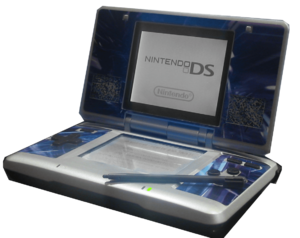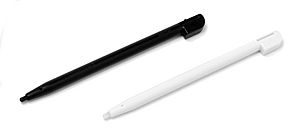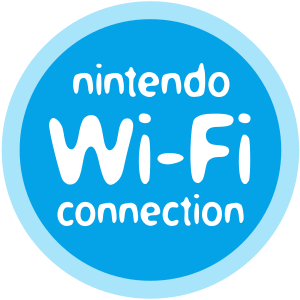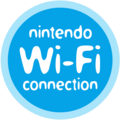Nintendo DS facts for kids

An electric blue Nintendo DS
|
|
| Developer | Nintendo |
|---|---|
| Manufacturer | Foxconn |
| Product family | Nintendo DS |
| Type | Handheld game console |
| Generation | Seventh |
| Release date | |
| Introductory price | US$149.99 |
| Discontinued | Yes; date undisclosed |
| Units sold | 154.02 million worldwide (as of June 30, 2016[update]) (details) |
| Media | Nintendo DS Game Card Game Boy Advance Game Pak |
| CPU | 67 MHz ARM946E-S 33 MHz ARM7TDMI |
| Memory | 4 MB RAM |
| Storage | Cartridge save 256 KB flash memory |
| Display | Two TFT LCDs, 256 × 192 pixels |
| Connectivity | Wi-Fi (802.11, WEP) |
| Online services | Nintendo Wi-Fi Connection |
| Best-selling game | New Super Mario Bros., 30.80 million (as of September 30, 2016[update]) |
| Backward compatibility |
Game Boy Advance |
| Predecessor | Game Boy Advance |
| Successor | Nintendo 3DS |
The Nintendo DS is a popular handheld game console made by Nintendo. It was first released around the world in 2004 and 2005. The "DS" stands for "Developers' System" or "Dual Screen," which makes sense because it has two screens!
This console brought exciting new features to handheld gaming. It has two LCD screens that work together, with the bottom one being a touchscreen. It also has a built-in microphone and can connect to other devices wirelessly. The DS folds up like a clamshell design, similar to the Game Boy Advance SP.
One cool feature was that multiple DS consoles could connect directly to each other using Wi-Fi over a short distance. You didn't even need an internet connection for this! For online play, you could use the Nintendo Wi-Fi Connection service, though that service is no longer active. The main competitor for the Nintendo DS was Sony's PlayStation Portable.
When it was first announced, Nintendo said the DS would be a "third pillar" alongside their other consoles, the Game Boy Advance and GameCube. But because it could play Game Boy Advance games and sold so well, it became the next big thing after the Game Boy series.
Nintendo later released updated versions:
- The Nintendo DS Lite came out in 2006. It was thinner, lighter, and had brighter screens and a longer battery life.
- The Nintendo DSi was released in 2008. It had better hardware and new features, like cameras. However, it couldn't play Game Boy Advance games anymore.
- The Nintendo DSi XL (2009) was a bigger version of the DSi with larger screens.
All the Nintendo DS models combined have sold over 154 million units worldwide. This makes it Nintendo's best-selling system and the second best-selling video game console ever, right after the PlayStation 2. The Nintendo 3DS took its place in 2011.
History of the Nintendo DS
How the DS was Developed
Nintendo started working on the DS around mid-2002. The idea for a dual-screen console came from former Nintendo president Hiroshi Yamauchi. In January 2004, Nintendo officially announced the console, calling it "Nintendo DS" for now. They said it would have two 3-inch screens and special processors.
Satoru Iwata, who was Nintendo's president at the time, said they wanted to create a "unique entertainment experience." He hoped the DS would help Nintendo be known for new ideas again. A document later leaked, showing its secret development name was "Nitro." The console was first shown to the public at a big event called E3 in May 2004.
In July 2004, Nintendo showed off a new, sleeker design and confirmed "Nintendo DS" as the official name.
Launching the Console
Nintendo wanted the DS to reach many different types of players. They launched the Nintendo DS in North America on November 21, 2004, for US$149.99. It then came out in Japan on December 2, 2004, for JP¥15,000. Australia got it on February 24, 2005, and Europe on March 11, 2005.
Nintendo decided to launch the DS in North America first, which was unusual for them. They did this to be ready for "Black Friday", a huge shopping day in the U.S. The DS was incredibly popular, selling over 500,000 units in its first week in the U.S. By the end of 2004, 2.8 million units had been shipped worldwide, much more than Nintendo expected!
Some early DS consoles had small problems with "stuck pixels" on the screens. Nintendo offered exchange programs for players who felt this affected their gaming.
When the DS launched in North America, it came with a demo game called Metroid Prime Hunters: First Hunt. Later, in June 2005, some systems were bundled with Super Mario 64 DS.
How the DS was Promoted
Nintendo's advertising for the DS often used the word "Touch." For example, the North American slogan was "Touching is good."
Many people thought the Nintendo DS would compete directly with Sony's PlayStation Portable. However, both companies said their systems were for different kinds of players. Time magazine even gave the DS a "Gadget of the Week" award.
The price of the Nintendo DS dropped from US$149.99 to US$129.99 in August 2005, just before popular games like Nintendogs and Advance Wars: Dual Strike were released.
The Nintendo DS came in many colors. The original model was available in Titanium (gray). Other colors like Electric Blue, Red, Graphite Black, Pure White, Turquoise Blue, and Candy Pink were released in different regions or with special game bundles.
Sales Success
The Nintendo DS was a massive success! As of March 31, 2016, all Nintendo DS models combined had sold 154.02 million units. This makes it the best-selling handheld game console ever and the second best-selling video game console of all time.
The Legacy of the DS
The Nintendo DS changed gaming by making touchscreen controls and wireless online gaming popular for many people. It was often the first time many players experienced touch technology.
The DS also created a huge market for "casual gaming" and attracted many people who weren't traditional gamers. It helped make touchscreens the standard for future portable devices, including smartphones. Some experts believe the DS helped prepare the world for the iPhone and mobile gaming apps.
The DS also brought more female gamers into the world of video games. In 2006, Nintendo reported that 44% of DS owners were female, with most Nintendogs players being girls.
The success of the DS led to its successor, the Nintendo 3DS. This console also has two screens, but the top screen can show images in 3D without needing special glasses!
Nintendo DS Hardware
The Nintendo DS looks a bit like Nintendo's old "Game & Watch" handhelds, which also had multiple screens.
The bottom screen of the DS is a resistive touchscreen. This means you can use the included stylus, your fingers, or a special plastic tab to control things. The touchscreen lets you interact with games directly. For example, in the built-in chat program PictoChat, you use the stylus to write messages or draw.
The DS has classic gaming buttons: X, Y, A, B, a directional pad (D-pad), and Start, Select, and Power buttons. On the top, there are two shoulder buttons, a slot for DS game cards, a stylus holder, and a power input. On the bottom, there's a slot for Game Boy Advance game cartridges. The button layout is similar to the Super Nintendo Entertainment System controller. When playing Game Boy Advance games, the X, Y, and touchscreen are not used because GBA systems didn't have them.
The console also has stereo speakers on either side of the top screen, offering virtual surround sound in some games. This was new for a Nintendo handheld. A microphone is built-in below the bottom screen. It's used for things like speech recognition, chatting with friends, or mini-games where you might need to blow or shout into it.
Technical Details
The Nintendo DS is light, weighing about 275 grams (9.7 ounces). When closed, it's about 14.8 cm wide, 8.4 cm tall, and 2.8 cm deep.
Each of its two screens is about 7.7 cm (3 inches) diagonally and has a resolution of 256 x 192 pixels. They can display over 262,000 colors.
Inside, the DS has two ARM processors. The main one runs at 67 MHz and handles the game's action and graphics. A second processor runs at 33 MHz and helps with sound and Wi-Fi. It has 4 MB of RAM.
The DS can connect to Wi-Fi networks (using an older type of security called WEP). This was used for the Nintendo Wi-Fi Connection service, allowing players to compete online or chat.
Nintendo said the battery could last up to 10 hours on a full charge, but this depends on how you use it (like speaker volume or screen brightness). You can easily replace the battery yourself with a screwdriver.
When you close the Nintendo DS, it goes into "sleep mode." This pauses your game and saves battery by turning off the screens, speakers, and wireless features. However, some games, like Game Boy Advance games, won't pause when you close the system. Some DS games even used the closing motion as part of a puzzle!
Extra Accessories
The Nintendo DS has a second slot at the bottom, mainly for Game Boy Advance games. But Nintendo also designed it for various accessories. (Note: The Nintendo DSi doesn't have this second slot, so it can't use these accessories.)
- Rumble Pak: This accessory looks like a GBA cartridge and vibrates when certain things happen in compatible games, like hitting an obstacle.
- Headset: This official headset plugs into the bottom of the DS. It has one earphone and a microphone, letting you chat or use voice commands in games.
- Browser: Nintendo released a special version of the Opera web browser for the DS. It needed a memory expansion pak that plugged into the GBA slot.
- Wi-Fi USB Connector: This small device plugged into a computer's USB port and created a mini Wi-Fi hotspot. This allowed your DS (or Wii) to connect to the Nintendo Wi-Fi Connection through your computer's internet.
- MP3 Player: This accessory, also known as Play-Yan in Japan, let you play MP3 music files from an SD card using the GBA slot.
- Guitar Grip Controller: This controller came with the Guitar Hero: On Tour game. It plugged into the GBA slot and had four colored buttons, letting you play guitar-style games.
Later Models of the DS
Nintendo DS Lite
The Nintendo DS Lite was the first updated version of the Nintendo DS. It kept the main features but looked much sleeker. It had a bigger stylus, a longer-lasting battery, and brighter screens. It was also the last DS model that could play Game Boy Advance games.
Nintendo DSi
The Nintendo DSi was the second update. It added new features like two 0.3-megapixel digital cameras (one inside, one outside). It also had a slightly larger 3.25-inch screen and could connect to the Nintendo DSi Shop to download games and apps. However, it removed the Game Boy Advance slot.
The Nintendo DSi XL (called DSi LL in Japan) was an even larger version of the DSi. It had bigger screens with wider viewing angles and an improved battery life. Nintendo suggested the DSi XL was great for sharing with family members in a living room.
Software and Features
Nintendo Wi-Fi Connection
The Nintendo Wi-Fi Connection was a free online gaming service from Nintendo. If you had a compatible DS game, you could connect to the service using a Wi-Fi network or a special Nintendo Wi-Fi USB Connector. The service launched in North America, Australia, Japan, and Europe in late 2005. The first game to use it was Mario Kart DS.
Many Nintendo DS games and even a web browser used this service. Nintendo felt its success helped make the entire DS system so popular. Most of the online functions for both DS and Wii games were stopped worldwide on May 20, 2014.
Download Play
With Download Play, you could play multiplayer games with other Nintendo DS (and later 3DS) systems using only one game card. One person would host the game, and others could download a small part of the game to their systems wirelessly. You needed to be close to each other (about 65 feet). Not all games supported this, and sometimes the features were limited compared to the full game.
Download Play was also used at special "DS Download Stations" in stores, where you could download demos of new games. These demos would disappear once you turned off your DS.
Multi-Card Play
Multi-Card Play also lets you play multiplayer games with other DS systems, but in this mode, each player needs their own game card. You would access this mode from a menu within the game itself.
PictoChat
PictoChat was a fun built-in program that let you chat with other Nintendo DS users nearby wirelessly. You could type messages using an on-screen keyboard, or even handwrite messages and draw pictures with the stylus on the touchscreen. There were four chatrooms (A, B, C, D), and up to sixteen people could join each room.
On the original DS and DS Lite, you could only write in black. But on the DSi and DSi XL, you could write in a rainbow of colors that slowly changed. PictoChat was not included on the Nintendo 3DS.
System Software (Firmware)
The Nintendo DS has its own special software, called firmware, that runs when you turn it on. First, you see a health and safety warning. Then, the main menu appears. From here, you can choose to play a DS game, use PictoChat, start Download Play, or play a Game Boy Advance game. The menu also has settings for things like the backlight, an alarm, and your personal information.
The DS supports several languages: English, Japanese, Spanish, French, German, and Italian. In China, Chinese replaces Japanese, and in Korea, Korean replaces Italian.
Games for the DS
Playing Older Games (Compatibility)
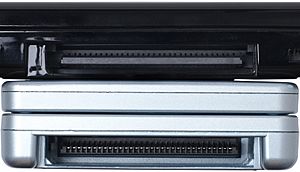
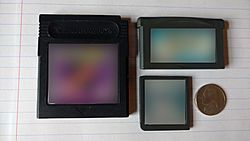
The Nintendo DS can play Game Boy Advance (GBA) games. DS game cards fit into a slot on the top, while GBA games fit into a slot on the bottom. However, the DS cannot play games made for the older Game Boy or Game Boy Color.
When playing GBA games, the DS only uses one screen (you can choose the top or bottom). The games appear with a black border because the DS screen has a slightly different resolution than the GBA.
Some Nintendo DS games could even detect if a specific Game Boy Advance game was in the bottom slot. For example, in Pokémon Diamond and Pearl, having certain GBA Pokémon games inserted would let you find special Pokémon in the wild!
The GBA slot was also used for accessories like the Rumble Pak, the Nintendo DS Browser's memory expansion, and the Guitar Grips for Guitar Hero: On Tour games. Remember, the Nintendo DSi and DSi XL don't have this GBA slot, so they can't play GBA games or use these accessories.
Game Regions
The Nintendo DS is mostly "region free." This means you can play a Nintendo DS game from any country on any DS console. However, games made for the Chinese iQue DS could only be played on iQue DS consoles because they needed special Chinese characters that other DS systems didn't have.
Also, some multiplayer games that require both players to have a game card might not work together if the games are from different regions. But with the Nintendo Wi-Fi Connection, many games allowed you to play online with people from different regions.
The Nintendo DSi, however, has a region lock for games downloaded from the DSiWare shop and for special DSi-specific game cards. But it can still play regular DS games from any region.
Game Card Details
Nintendo DS games come on special game cards. These cards use a type of memory called "mask ROM." They can hold between 8 and 512 megabytes of data. Larger cards might transfer data a bit slower. The cards usually have a small amount of flash memory to save your game progress or high scores. DS game cards are quite small, about 35 x 33 x 3.8 mm, and weigh around 3.5 grams.
Hacking and Homebrew
In some places, like South Korea, many people used illegal copies of DS games. In 2007, over 500,000 illegal copies were sold there.
Another device called Action Replay, made by Datel, allowed users to enter cheat codes. These codes could give players things like unlimited health, special power-ups, access to any part of a game, or even let them walk through walls!
Images for kids
-
Game Boy Advance game slot on Game Boy Advance SP (below) and Nintendo DS Lite (above)
-
Clockwise from left: A Game Boy Color game cartridge, a Game Boy Advance game cartridge, and a Nintendo DS game cartridge. On the far right is a United States Nickel shown for scale.
See also
 In Spanish: Nintendo DS para niños
In Spanish: Nintendo DS para niños


